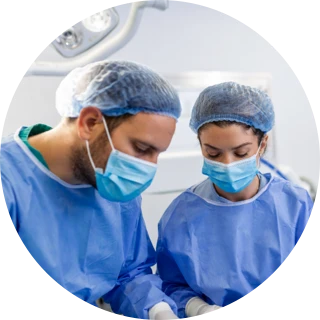Information
The operation is performed by a miniature doppler ultrasound device to locate all the arteries supplying the haemorrhoids as they come down from the rectum under the lining of the bowel. The device also has a small window which allows a stitch to be placed around the artery thus cutting off the blood supply to the pile. During the course of the procedure all the arteries supplying the piles are located and tied off. Over the next few days and weeks the pile shrinks away and the symptoms resolve.
Because the stitch is placed in the lower rectum, where there are virtually no pain nerves, rather than in the anus the procedure is virtually painless and can be performed under mild sedation if preferred, rather than a general anaesthetic. Naturally, patients who are a little squeamish about having a procedure to their bottom can elect to have a general anaesthetic if they wish but it is not necessary. Because all of the blood vessels to the piles are accurately located the operation is more successful than injection; and as the blood vessels are properly ligated rather than just looped with a band they will not dislodge, producing a better response with far less risk of bleeding after the procedure.
Most patients are back to work after 24-48 hours with only a minimum of discomfort, which if there is any, is no more than a mild a throbbing in the rectum.
This procedure has been performed in Europe and North America now for many years with excellent results. 85% of patients have a complete resolution of their symptoms and over 90% are thoroughly pleased with the result even if there are some very minor residual symptoms. This is due to the relative ease of recovery from the operation compared to more conventional treatment options.
“I think the method is very suitable for patients in the second and third stage of the disease when the anal prolapse occurs. It is friendly, does not require anesthesia very and recovery takes 2-3 days.”, says dr. Rossen Tushev – surgeon at
How can this method help me?
It is the first method to utilize minimally invasive surgical techniques to treat the source of hemorrhoidal disease without surgical excision, stapling or banding.
How long does the procedure take, will I be hospitalized, and when can I go back to work?
The procedure can take as little as twenty minutes and patients usually leave the same day. Most patients experience only minor pain and discomfort, and return to work the next day.
What kind of care will I need before, during, and after the procedure? What medications will the doctor prescribe?
Discuss this in-depth with your physician as your age, weight, and physical condition will influence how you are medicated and managed during and after the procedure. Your surgeon may opt to forgo general anesthesia for conscious sedation. Again, you should discuss these options with your doctor. Results are variable but post-procedural pain medications are usually minimal and for limited duration.



 On this page, you can change your choices at any time after you have read and understood our
On this page, you can change your choices at any time after you have read and understood our